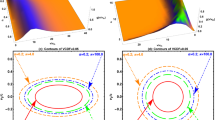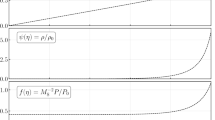Abstract
A spherical plasma inhomogeneity located at mesospheric altitudes in a thundercloud quasi-electrostatic field is considered as a possible cause of sprite formation. A simple semianalytical model of ionization instability in a quasi-electrostatic field, the value of which is larger than the air breakdown value, is developed on the assumption that plasma ball conductivity is controlled by impact ionization and electron attachment to neutrals. After several simplifications, the problem is reduced to a system of ordinary differential equations for the average conductivity and plasma ball radius. The analytical estimates and numerical simulation indicate that the predicted expansion rate and acceleration of the plasma inhomogeneity boundary are close in magnitude to the values observed during high-speed imaging of sprite development.
Similar content being viewed by others
References
Boccippio, D.J., Williams, E.R., Heckman, S.J., Lyons, W.A., Baker, I.T., and Boldi, R., Sprites, ELF transients, and positive ground strokes, Science, 1995, vol. 269, no. 5227, pp. 1088–1091.
Cummer, S.A., Jaugey, N., Li, J., Lyons, W.A., Nelson, T.E., and Gerken, E.A., Submillisecond imaging of sprite development and structure, Geophys. Res. Lett., 2006, vol. 33, L04104. doi 10.1029/2005GL024969
Evtushenko, A.A. and Mareev, E.A., Simulation of mesospheric- composition disturbances under the action of high-altitude discharges (sprites), Radiophys. Quantum Electron., 2011, vol. 54, no. 2, pp. 111–127.
Hiraki, Y. and Fukunishi, H., Theoretical criterion of charge moment change by lightning for initiation of sprites, J. Geophys. Res., 2006, vol. 111, A11305. doi 10.1029/2006JA011729
Hu, W., Cummer, S.A., and Lyons, W.A., Testing sprite initiation theory using lightning measurements and modeled electromagnetic fields, J. Geophys. Res., 2007, vol. 112, D13115. doi 10.1029/2006JD007939
Kosar, B.C., Liu, N., and Rassoul, H.K., Luminosity and propagation characteristics of sprite streamers initiated from small ionospheric disturbances at subbreakdown conditions, J. Geophys. Res., 2012, vol. 117, A08328. doi 10.1029/2012JA017632
Landau, L.D. and Lifshits, E.M., Elektrodinamika sploshnykh sred (Electrodynamics of Continuous Media), Moscow: Nauka, 1982.
Li, J. and Cummer, S.A., Measurement of sprite streamer acceleration and deceleration, Geophys. Res. Lett., 2009, vol. 36, L10812. doi 10.1029/2009GL037581
Liu, N.Y., Pasko, V.P., Adams, K., Stenbaek-Nielsen, H.C., and McHarg, M.G., Comparison of acceleration, expansion, and brightness of sprite streamers obtained from modeling and high-speed video observations, J. Geophys. Res., 2009, vol. 114, A00E03. doi 10.1029/2008JA013720
Luque, A. and Ebert, U., Emergence of sprite streamers from screening-ionization waves in the lower ionosphere, Nat. Geosci., 2009, vol. 2. doi 10.1038/ngeo662
Luque, A. and Ebert, U., Sprites in varying air density: Charge conservation, glowing negative trails and changing velocity, Geophys. Res. Lett., 2010, vol. 37, L06806. doi 10.1029/2009GL041982
McHarg, M.G., Haaland, R.K., Moudry, D., and Stenbaek-Nielsen, H.C., Altitude–time development of sprites, J. Geophys. Res., 2002, vol. 107, no. A11. doi 10.1029/2001JA000283
McHarg, M.G., Stenbaek-Nielsen, H.C., and Kammae, T., Observations of streamer formation in sprites, Geophys. Res. Lett., 2007, vol. 34, L08804. doi 10.1029/2006GL027854
Pasko, V.P., Qin, J., and Celestin, S., Toward better understanding of sprite streamers: Initiation, morphology, and polarity asymmetry, Surv. Geophys., 2013, vol. 34, no. 6, pp. 797–830. doi 10.1007/s10712-013-9246-y
Qin, J., Celestin, S., and Pasko, V.P., On the inception of streamers from sprite halo events produced by lightning discharges with positive and negative polarity, J. Geophys. Res., 2011, vol. 116, A06305. doi 10.1029/2010JA016366
Raizer, Yu.P., Fizika gazovogo razryada (Gas Discharge Physics), Moscow: Intellekt, 2009.
Raizer, Y.P., Milikh, G.M., and Shneider, M.N., Streamerand leader-like processes in the upper atmosphere: Models of red sprites and blue jets, J. Geophys. Res., 2010, vol. 115, A00E42. doi 10.1029/2009JA014645
Stanley, M., Krehbiel, P., Brook, M., Moore, C., Rison, W., and Abrahams, B., High speed video of initial sprite development, Geophys. Res. Lett., 1999, vol. 26, no. 20, pp. 3201–3204.
Surkov, V.V. and Hayakawa, M., Underlying mechanisms of transient luminous events: A review, Ann. Geophys., 2012, vol. 30, no. 8, pp. 1185–2012. doi 10.5194/angeo- 30-1185-2012
Surkov, V. and Hayakawa, M., Ultra and Extremely Low Frequency Electromagnetic Fields, Springer, 2014.
Author information
Authors and Affiliations
Corresponding author
Additional information
Original Russian Text © V.V. Surkov, M. Hayakawa, 2016, published in Geomagnetizm i Aeronomiya, 2016, Vol. 56, No. 6, pp. 763–771.
Rights and permissions
About this article
Cite this article
Surkov, V.V., Hayakawa, M. Semianalytical models of sprite formation from plasma inhomogeneities. Geomagn. Aeron. 56, 724–732 (2016). https://doi.org/10.1134/S0016793216050145
Received:
Accepted:
Published:
Issue Date:
DOI: https://doi.org/10.1134/S0016793216050145




